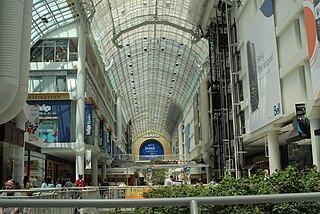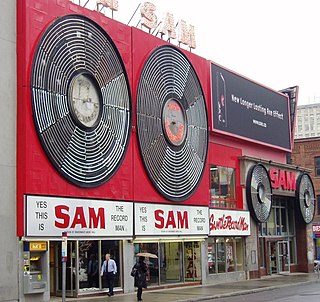
Yonge–Dundas Square, or Dundas Square, is a public square at the southeast corner of the intersection of Yonge Street and Dundas Street East in Downtown Toronto, Ontario, Canada. Designed by Brown and Storey Architects, the square was conceived in 1997 as part of revitalizing the intersection. Since its completion in 2002, the square has hosted many public events, performances and art displays, establishing itself as a prominent landmark in Toronto and one of the city's prime tourist attractions. Central to the Downtown Yonge entertainment and shopping district, the square is owned by the city and is the first public square in Canada to be maintained through a public-private partnership. The intersection is one of the busiest in Canada, with over 100,000 people crossing the city's first pedestrian scramble daily.

The Toronto Eaton Centre is a shopping mall and office complex in Downtown Toronto, Ontario, Canada. It is owned and managed by Cadillac Fairview (CF). It was named after the Eaton's department store chain that once anchored it before the chain became defunct in the late 1990s.

The T. Eaton Company Limited, commonly known as Eaton's, was a Canadian retailer that was once Canada's largest department store chain. It was founded in 1869 in Toronto by Timothy Eaton, a Presbyterian Ulster Scot immigrant from what is now Northern Ireland. Eaton's grew to become a retail and social institution in Canada, with stores across the country, buying-offices around the globe, and a catalogue that was found in the homes of most Canadians. A changing economic and retail environment in the late 20th century, along with mismanagement, culminated in the chain's bankruptcy in 1999.

Toronto Chinatowns are ethnic neighbourhoods in and around Toronto, Ontario, Canada, with a high concentration of ethnic Chinese residents and businesses. There are multiple Chinatowns in Toronto and the Greater Toronto Area.

Queen Street is a major east-west thoroughfare in Toronto. The western section begins at the intersection of Roncesvalles Avenue and King Street, where The Queensway continues it west. It extends eastward in a straight line to Yonge Street where it becomes Queen Street East, from there is extend eastwards until after Victoria Park Avenue near the R. C. Harris Water Treatment Plant; the road is covered by Toronto Transit Commission route 501 Queen, and some sections are covered by the 502 Downtowner. The centre lanes each way have streetcar, although like many Toronto streets, cars are generally permitted in these lanes.

PATH is a network of underground pedestrian tunnels, elevated walkways, and at-grade walkways connecting the office towers of Downtown Toronto, Ontario, Canada. It is more than 30 kilometres (19 mi) long. According to Guinness World Records, PATH is the largest underground shopping complex in the world with 371,600 square metres (4,000,000 sq ft) of retail space.

Dundas is a subway station on Line 1 Yonge–University in Toronto, Ontario, Canada. It is located at the intersection of Yonge Street and Dundas Street. Wi-Fi service is available at this station.

Bloordale Village is a Business Improvement Area (BIA) that is located along Bloor Street from Lansdowne Avenue to Dufferin Street, west of downtown in Toronto, Ontario, Canada. It sits on the southern border of the Wallace Emerson neighbourhood and the northern border of the Brockton Village neighbourhood. The district is home to a mix of shopping, bars and vintage clothing, book, and video stores. There are also many, many furniture stores.

Dundas Street, is a major historic arterial road in Ontario, Canada. The road connects the city of Toronto with its western suburbs and several cities in southwestern Ontario. Three provincial highways—2, 5, and 99—followed long sections of its course, although these highway segments have since been downloaded to the municipalities they passed through. Originally intended as a military route to connect the shipping port of York to the envisioned future capital of London, Ontario, the street today connects Toronto landmarks such as Yonge-Dundas Square and the city's principal Chinatown to rural villages and the regional centres of Hamilton and London.

The 504 King is an east–west streetcar route in Toronto, Ontario, Canada. It serves King Street in Downtown Toronto as well as Broadview Avenue on the east end and Roncesvalles Avenue on the west end of the line. The route consists of two overlapping branches: 504A between Dundas West station and Distillery Loop, and 504B Broadview station and Dufferin Gate Loop. The two branches overlap on King Street between Dufferin and Sumach streets, both passing St. Andrew station and King station on subway Line 1 Yonge–University.

The Garden District is a neighbourhood in downtown Toronto, Ontario, Canada. The name was selected by the Toronto East Downtown Residents Association (TEDRA) in recognition of Allan Gardens, an indoor botanical garden located nearby at the intersection of Carlton and Jarvis Streets. The Garden District was officially designated by the Mayor and Toronto City Council in 2001, while TEDRA has since been renamed the Garden District Residents Association. Part of the neighbourhood is within official City of Toronto neighbourhood of Moss Park.

College Park is a shopping mall, residential and office complex on the southwest corner of Yonge Street and College Street in Toronto, Ontario, Canada. An Art Deco landmark, the building was built between 1928 and 1930 by the Eaton's department store, and was designed by Ross and Macdonald, the Montreal architectural firm that also designed the Royal York Hotel and Maple Leaf Gardens in Toronto, the Château Laurier Hotel in Ottawa, and the Montreal Eaton's store.

Eaton Centre is a name associated with shopping malls in Canada, originating with Eaton's, one of Canada's largest department store chains at the time that these malls were developed. Eaton's partnered with development companies throughout the 1970s and 1980s to develop downtown shopping malls in cities across Canada. Each mall contained an Eaton's store, or was in close proximity to an Eaton's store, and typically the mall itself carried the "Eaton Centre" name. These joint ventures were a significant retail development trend in Canada during that period.

Atrium is a large 1,000,000 square feet (93,000 m2) retail and office complex in Toronto, Ontario, Canada. Atrium is located adjacent to the highly popular Yonge-Dundas Square, and was built upon the former site of the former Ford Hotel Toronto, on the north side of Dundas Street West, extending from Yonge Street to Bay Street. The mixed-use building was constructed in 1981 with parking on the second and third underground levels and retail space street and concourse levels topped by an eight-storey office block that rises to 14 floors on the east end of the site and 13 on the west. As part of downtown Toronto's PATH network, Atrium's Concourse Level is directly connected underground to the Dundas subway station, the Toronto Eaton Centre south, across on Dundas Street, and the Toronto Coach Terminal located west, across Bay Street.

Located on Albert Street, directly behind the Eaton's Main Store and Toronto's City Hall, the Eaton's Annex was a 10-storey building containing both retail and office space. By 1900, the Eaton's department store owned almost all of the lands within the city blocks bordered by Yonge Street, Queen Street West, Bay Street and Dundas Street, and the land was occupied by the Eaton's Main Store, the Annex building and various Eaton's warehouses and mail order buildings. The Main Store and the Annex, however, were the only two buildings open to the public. In 1900, the two buildings were connected by an underground passageway open to both employees and shoppers. It was the first underground pathway in Toronto open to the public, and is often credited as a historic precursor to Toronto's current downtown PATH network.

The Thornton–Smith Building, located at 340 Yonge Street, is a prominent heritage building in the heart of downtown Toronto, Ontario, Canada. Since the completion of the building in the twenties, Yonge Street has seen many transformations and while tenants in the building have reflected these changes The Thornton–Smith Building itself has remained true to its original architecture.






























